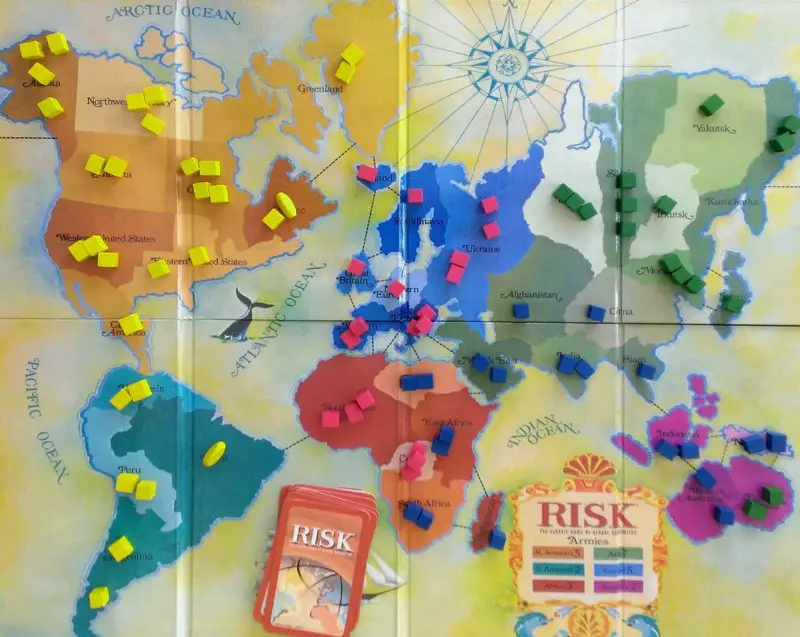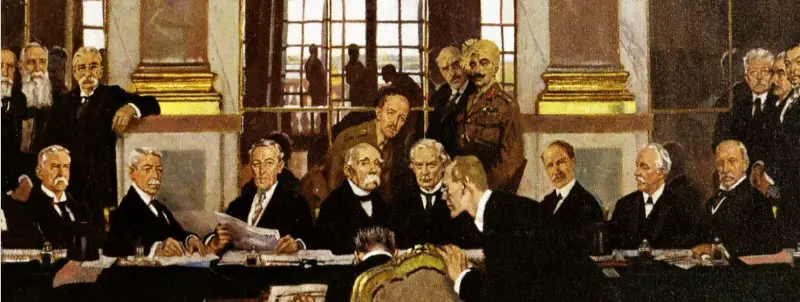
This variant is played with the 1975 version of game and adds resources (other than armies) and politics while keeping the game simple (by BGG standards). The three resources are; food (use green armies ~ Asia & Australia), oil (use black armies ~ Europe & Africa), and player armies (North and South America). Food and oil unit (armies) 'stockpiles' are kept hidden until used or traded.
Note: if more than 4 players are playing use other items to represent oil and food units (example; chips).
Setup
In addition to the regular army levels, players receive the initial oil and food levels outlined below:
| #Players | 2 | 3 | 4 | 5 | 6 |
|---|---|---|---|---|---|
| #Oil | 7 | 7 | 6 | 5 | 4 |
| #Food | 2 | 2 | 2 | 2 | 2 |
Turn Sequence Steps
1. Food Produced
Green FOOD units are produced in ASIA and AUSTRALIA. A die is rolled and used in the table to the right to find the number of food units produced in each food territory. Food units (green armies) are then distributed to players.
| Die Roll | Food units produced per food territory (Asia & Australia) |
|---|---|
| 6 | 3 |
| 3-5 | 2 |
| 1-2 | 1 (draught) |
2. Food Traded
Players openly discuss and make food trades, and trade per political agreements.
3. Food Consumed
Players turn in 1 food unit (1 green army) for each of their oil and army producing territories. If a player does not have enough food to feed all of his oil and army territories he chooses which territories do not eat.
A player cannot hold back feeding his territories; he must spend all of his food units before any territory can starve.
4. Armies & Oil Produced
3 armies are produced in each fed American territory (north and south) and 3 oils (black armies) are produced in each fed European and African territory. Oil and army territories that were not fed do not produce.
5. Armies & Oil Traded
Players openly discuss and make oil and army trades, and trade per political agreements.
6. Nuclear Builds
7. Political Discussions (secrete)
8. Political Announcements
Agreements end then new agreements can be made.
9. Turn Sequence
The player Military Step turn sequence is set based on most-to-least army strengths (on board plus new builds). In case of a tie the player with the most territories moves first. If still tied use a die roll.
Example: the player with the most armies gets turn #1, the player with the next most armies gets turn #2, etc.
10. Alliance Military Step
Alliances take their Military Step turns. An Alliance's turn number is the lowest turn number of all of its allied players. All allied players move on their alliance's turn, in their player turn order. Each player completes his Military Step (placing armies, making attacks, then making strategic moves) before the next player starts his turn.
11. Non-aligned Player Military Step
Non-aligned players take their Military Steps based on their player turn order of step '9'. Each player completes his Military Step before the next player starts his turn.

Trades
Players openly discuss and make trades. Trades can include exchanging any number of resources; food, oil, and armies. Trades do not need to be even; for example 3 oil units can be traded for 5 food units. Trades and quantities are at the discretion of the trading players, and can be kept concealed.
Trades cannot be blocked by other players.
Army and oil production can be "promised" during the food trade step but must be fulfilled in the next army and oil trade step. Players must complete their promised trades if they have the units.
Army Production
During the Armies and Oil Produced step, players produce their own color coded armies; 3 armies per fed army producing territory plus/minus any trades. Army production can be used during the game turn as regular armies, as insurgents, and exchanged to build nuclear weapons. A player must produce 3 regular armies before producing insurgents or exchanging for nuclear weapons.
Armies received in trades do not count towards the 3 army minimum and cannot be exchanged for insurgents or nuclear weapons. Army production is not kept concealed. Players place their army production on the game board in front of them when produced. Regular armies and insurgents are placed during a player's Military-army placement step; regular armies are placed in the owner's territories and insurgents are placed in other player territories.
Oil

Oil is needed to make attacks and to make a strong defense. Each time an attack is made, the attacker must turn in 1 oil unit (black army), regardless of the number of attacking armies. The defender may then choose to turn in 1 oil to defend, and rolls as in the regular Risk rules. If he chooses not to turn in an oil unit to defend, the following "automatic" die rolls apply:
1 defending army only: the defending army has a die roll of '1'..
2 or more defending armies; the defender rolls two dice of '2' each
Army Movement And Combat
Combat is resolved using up to 3 attacking dice and up to 2 defending dice and is resolved as in regular RISK. In addition:
Multiple Territories & Players
The attacking player can attack from multiple territories. In addition, players allied to the attacking player can add their armies to the attack with the attacking player's permission. More than 3 attacking armies can be committed. The attacking player or any player allied to him then spends 1 oil unit. Similarly, the defending player can move additional armies into the attacked territory from any neighboring territories, as well as any player allied to the defending player with the defending player's permission.
The defending player or any player allied to him then chooses to spend an oil unit or all agree not to spend oil. Attacker combat losses are chosen by the attacking player; defending combat losses are chosen by the defending player. Losses can be taken from any attacking and defending "committed" armies. After combat, if the territory is vacant of the original defending player armies plus all armies of his allies, armies of any player who was committed to the last attack can advance armies from any/all neighboring territories.
The attacking player can give permission to his other allies to advance armies into the territory. Armies of players not aligned to the attacker or defender do not participate in the battle.
Capturing Armies
When a die roll of '6' defeats a die roll of '1', the defeated army is captured (attacking or defending army). Except: the defender chose not to use oil to defend. The capturing player places the captured army in front of him and exchanges it for one of his own during the next army production step.
Retreat
Immediately following an attack, players with armies in the defending territory can chose to retreat them from the territory and into any neighboring territories, providing the attacking side has at least 1 army left for advancement. Armies can retreat into an allied player's territory only with his permission.
Strategic Movement
At the end of the Military step, the moving player can make 5 strategic moves. A player's strategic move is moving any number of his armies from 1 territory, through any connected number of territories, to any other territory. In addition to moving through his own territories, he can also move through territories of his allies as well as those of players who surrendered to him and with whom he also has a non-aggression pact.
The player can end his strategic move in his own territory or those of his allies or the surrendered player with the player's permission.
Similarly a player can use his strategic move to move armies of any of his allies.
Insurgents
During the Military-army placement step, a player who has 4 or more new production armies may place one of these in any territory that belongs to a player other than himself, one of his allies, or a player with whom he has a non-aggression pack.
Once placed, the insurgents are not required to attack other armies in the territory; they can remain in the territory waiting for additional insurgent armies to be placed, challenge ownership, attack inside the territory, or attack into a neighboring territory at a later time. If the insurgent armies are the only armies left in a territory, they become regular armies and take possession of the territory.
Army Stacking & Territory Ownership
A territory can have armies of more than 1 player. The armies can move into the territory during strategic movement or retreat or could have been placed there as insurgents. For clarity, the territory's RISK card is given to the owning player at the time of army movement or placement and is retained as long as he has ownership.
Any player with armies in the territory can challenge territory ownership during his Military-attack step. When ownership is challenged, one of the following occurs:
All players with armies in the territory agree on the new owner; the territory's RISK card is given to the new owner.
Players cannot agree on ownership; the challenger announces a civil war attack.
Allied Players & Non-Aggression Pacts: A player must agree with the current territory owner if aligned to him or if he has a non-aggression pact with him. If not, the player must agree with the challenger's choice of ownership if aligned to him or if he has a non-aggression pact with him.
Civil War Attacks: Civil war attacks are resolved in the same way as regular attacks except all attacking and all defending armies must be inside the civil war territory. At least 1 attacking and 1 defending army must start the attack in the civil war territory, other armies may move into the territory from neighboring territories as they are added to the attacking or defending sides, and then the attack is resolved.
After each attack players can retreat their armies out of the civil war territory. Once all retreats are completed, all players with armies remaining inside the territory discuss territory ownership as explained above.
Political

Political rules in this variant greatly strengthens alliances in the game; without them "allied" players almost always attack each other as soon as an opportunity presents itself, long before the "enemy" players are defeated.
This is historically inaccurate and makes for a less fun game. In addition, with the oil rules once a player runs out of oil he can easily be overrun. The political rules allow a player who runs out of oil or armies to surrender to the attacking players, gain a non-aggression pack and stay in the game. It also allows the attacking players to save their armies (not having them lost in attacks) and gain production of territories protected by the defeated player's armies. It is not uncommon for a player who surrenders in the "first war" to come out in second place by game end. The political rules in this game are binding and add a great deal to its playability.
Political agreements are recorded on paper and cannot be broke (except during surrenders and for unilateral nonaggression pacts). Political agreements can be made during the Political Agreement step or immediately after an attack.
They can be specified to last a minimum of 2 game turns and a maximum of 5 game turns, ending at the start of the Political Agreement step on the specified game turn. Political agreements are restricted to the following:
Non-aggression Pacts
Players who enter into a non-aggression pact cannot attack each others' armies, including insurgents, nor can they advance after combat into each other's territories (ownership at the start of the attack). Non-aggression pacts cannot be violated even if a player allied to one non-aggression pact player attacks the other non-aggression pact player.

Conditional Non-aggression Packs
Conditional non-aggression pacts are non-aggression pacts in which one or more players of the pact agree to trade food, oil, and/or army production during the Trade steps (at any negotiated exchange 'ratio'). Trades can be specified as units or a fraction of total production. Players must meet their promised trades unless they do not produce enough, in which case the "shorted" players can choose to terminate the nonaggression pact at the time of "default".
Unilateral Non-aggression Packs
When a "defeated" player surrenders to "victorious" players, he quits any alliance to which he belongs and makes a unilateral non-aggression pact with his "previous allied" players. The unilateral non-aggression pact is recorded to end when the alliance was due to end even if in less than 2 game turns.
Unilateral non-aggression pacts are the same as non-aggression pacts except any "allied player" (not the "defeated" player) can break the unilateral non-aggression pact at any time. If an "allied player" breaks the pact, it is broke for all "allied players" and the "defeated" player can then immediately join the "victorious" players' alliance.
Alliances
Players can form new and join existing alliances with other players anytime during the Political Announcement step and immediately after being attacked during the Military step. If a player joins or forms an alliance during the Military step, he takes his turn with his new alliance.
If the alliance has already had its turn, he takes his turn immediately after the current player/alliance completes its Military turn. If the player has already taken his turn he does not get another turn. Players can be in only one alliance at a time. Alliances have the following benefits:
Non-Aggression Pact: Allied players have a non-aggression pact with each other, for the duration of the alliance.
Military Step: Alliances (and their allied players) take their Military Steps prior to unaligned players.
Allied Attacks: Allied players can group their armies for attacks and defense. They can also advance after combat together capturing territories together.
Allied Strategic Moves: Allied players can move through their allies' territories and can use their strategic movement to move their allies' armies.
Conditional Surrenders

A player can offer to surrender to the moving attacking "victorious" player (if aligned, to the "victorious" alliance players) anytime during the Military step. The surrendering player can offer territory, army reductions, oil and food stockpiles, and promise future food, oil, and/or army production payments to the victorious players for a non-aggression pack in return.
If to a victorious alliance, the surrender must be negotiated with and accepted by all players of the victorious alliance or the surrender cannot be made.
Surrenders include the following:
The surrendering player quits any alliance to which he belongs and makes a unilateral non-aggression pact with his previous allies.
The surrendering player forms a non-aggression pact with all victorious players. If he promises food, oil, or army production this is made a conditional non-aggression pact.
Surrender terms can include any of the following:
a) The surrendering player can give any of his food and oil stockpile units and unplaced new production armies to the victorious players.
b) The surrendering player can give the victorious players any of his territories.
c) The surrendering player can voluntarily destroy any number of his armies ~ for every 4 armies voluntarily destroyed, 1 victorious player (as negotiated) gets 1 army ~ placed with new production or immediately on board if new production has already been placed.
Unconditional Surrenders
A player can unconditionally surrender to other players anytime during the Military step. Unconditional surrenders must be accepted.
Surrender procedure is as follows.
The surrendering player quits any alliance to which he belongs and makes a unilateral non-aggression pact with his previous allies.
The surrendering player forms a conditional non-aggression pact with all victorious players - the surrendering player promising ½ of his food, oil, and army production as payments to the victorious players for the next 2 game turns - production divided evenly between all victorious players every Trade step.
The surrendering player gives ½ of his food and oil stockpile units to the victorious players - divided evenly between all victorious players or as they choose.
The surrendering player's unplaced new army production (if any) is divided evenly among all victorious players, or divided as they choose
All surrendering player armies in territories not owned by the surrendering player are destroyed.
The victorious players take turns claiming one territory each until ½ of the surrendering player's territories have been claimed. The surrendering and victorious players move armies freely between territories as required.
The surrendering player reduces his army strength in each of his remaining territories by ½ (reductions rounded down, example: 3 armies are reduced to 2 armies, 1 army is not reduced). Set army reductions aside. Once all reductions are done ~ for every 4 army unit reductions, 1 victorious player builds 1 army (which player as negotiated or using a die roll) ~ placed with new production or immediately on board if production was already taken.
Nuclear

Prior to starting play, players agree to the real-time hour: minute that nuclear weapons enter the game (normally ½ hour prior to desired game end time).
Nuclear weapons can be built during the first Nuclear Builds step after or during the "nuclear entry time".
Three 3 regular armies must be built from production prior to additional production armies being exchanged for nuclear weapons. Army trades cannot be used as the 3 army build minimum or as exchanges for nuclear weapons.
Capturing Nuclear Weapons
Nuclear weapons can be captured by destroying all enemy armies in the territory holding the weapons.
ICBMs
Any number of ICBMs can be built. Two 2 ICBMs (black armies) are built for each production army exchanged. The producing player places the exchanged armies back in their box and places the ICBMs in any of his territories. ICBMs have an unlimited range and cannot be intercepted or stopped.
The player can "launch" his ICBMs during any player's Military step against any territory. Once launched, no discussions or negotiations are allowed. Prior to impact, the owner of the targeted territory can choose to launch any ICBMs from the targeted territory, placing them off to the side if he does so. The original ICBM then hits the targeted territory destroying all armies and un-launched nuclear weapons in the territory.
The ICBM (black army) is then placed in the territory showing the territory is destroyed; no armies or weapons can move into or through the territory and it does not produce. Once the ICBM impact has been resolved, the other ICBMs that were launched during the attack are resolved in the same manner.
Once thirteen (13) territories have been destroyed by ICBMs, the game is over with no winners.
Tactical
Any number of tactical nuclear weapons can be built. Four 4 tactical nuclear weapons (green armies) are built for each army exchanged. The producing player places the exchanged armies back in their box and places the tactical weapons on any of his territories. Tactical weapons can be launched against enemy armies attacking the territory in which they are based; each launched tactical weapon destroys one attacking army.
Launched tactical weapons are placed back in their box once launched. Tactical weapons do not cause any other damage or permanent damage to the territory. Tactical nuclear weapons move like armies; advancing with attacking armies and using strategic movement.
Optional Nuclear
A more historically accurate nuclear rules are as follows:
On the game turn of nuclear entry, only the player with the most army producing territories can make nuclear weapons. He can only make 2 ICBMs by exchanging 1 army and can do so only if he first makes 3 or more armies. These nuclear weapons can be placed in any territory with his armies but can only be launched against neighboring territories.
On the next game turn, the next highest army producing player can also produce ICBMs. The first player can produce 4 ICBMs at a cost of 2 armies and the second nuclear player can only produce 2 ICBMs at a cost of 1 army. The players can produce the nuclear weapons only if they first make 3 or more armies. As in step 'a' these nuclear weapons are placed on board with their armies and can only be launched against neighboring territories.
On the following game turn the regular nuclear rules are used.
Continue Reading


